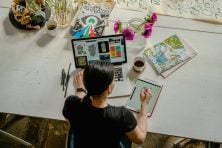My New Normal: Approaching Month 3 of Working From Home

Carin Panganiban is a designer at Microsoft and works from its headquarters in Redmond, Washington. She has been working from home since March 2, at the start of the COVID-19 outbreak in the United States. She shares what life has been like working remotely for nearly two months, as told to senior writer Nicole Dow.
Saturday, Feb. 29, was the first death in Kirkland, Washington — where I live. It happened at Evergreen Hospital, which is four minutes from me.
It was just a matter of days before we felt the effect at work. At first, it was messages from work advising against nonessential travel. By Tuesday, my company said to work from home if you can, especially if you’re sick. By Wednesday, the message shifted to: Just stay home.
I started working from home that Monday — both because I live right in Kirkland and because my son was coughing that week, which normally wouldn’t be a major deal. He had started coughing a few days before, so we were staying home and watching his symptoms.
Much of the first week working remotely was spent trying to wrap our heads around what was happening. We were all very distracted and trying to figure out what was going on. For me personally, it took probably three weeks before I really settled into a routine, before I realized we’re really in this for the long haul.
In all the articles you read about working from home, everyone tells you to wear real clothes. But it took me, like, three weeks before I listened to that advice. It really does change your mental state. It helps you be more productive, just more ready to work.
Getting a desk and a monitor also helped. Before that, I was very much working from bed.
In my role at work, a lot of what I do is really easy to duplicate online. Many of the tools I normally work with in the office are built for remote collaboration. But as a designer, I used to spend a lot of my time whiteboarding and drawing pictures, standing up next to a coworker and feeding off of each other’s energy. That part has been harder.
We have tried a few things. We’ve tried whiteboarding apps. We’ll do calls just to talk out things and brainstorm with each other. But it’s definitely not the same as being side by side with a person and figuring out things together.
However, I feel like this situation has made our coworker relationships a little closer. We’re all in this crisis together. We’re all seeing each other in a different light.
Even though Microsoft has a flexible working culture, I tend to stick to a pretty strict 9-to-5 schedule to help separate work life and home life.
I feel like there are three stages of adjusting to this new work-from-home life. The first stage was just figuring out how to do some semblance of work in the midst of a global crisis. In the second stage, you have more of a routine, you probably have a better setup and you’re wearing jeans instead of pajama pants, but you’re still very much trying to mimic what life was like at the office.
I think this third stage is more about accepting this will be your new normal for a very long time and figuring out how to make the most of it. How can we be better workers remotely? How can we do our best work in this situation?
I think I’m starting to get to that third stage now.
Nicole Dow is a senior writer at The Penny Hoarder.
















